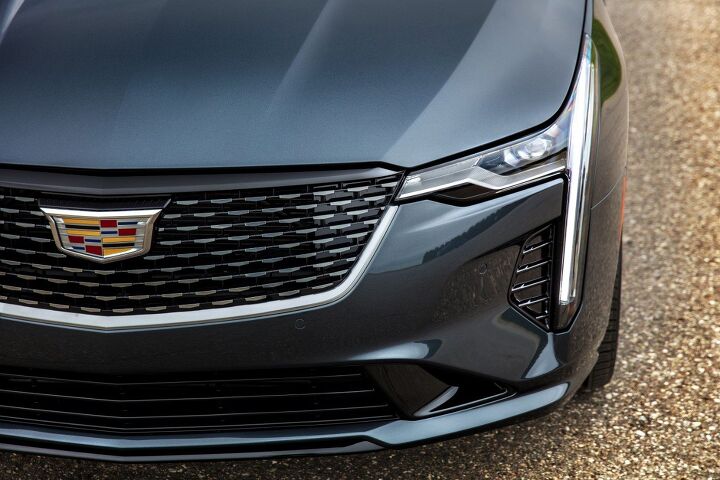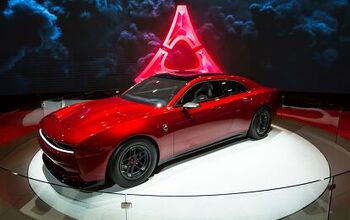Steve Carlisle Consults Magic 8-Ball, Sees Caddy's Future

If Cadillac President Steve Carlisle’s vision turns into a reality, we’re in for plenty of disruption by the end of the coming decade.
The brand chief’s vision, shared by many in the industry (especially overseas), depicts a land almost completely devoid of new internal combustion vehicles. That includes a marque that once fielded an 8.2-liter V8.
You’ve heard it all before — following a long lead-up that served to grow public awareness, the tsunami of electric vehicles about to spill onto our shores will catch fire with consumers, leading to a tipping point of acceptance. At that point — mid-decade is always the target — gasoline engines, regardless of their efficiency or cost effectiveness, will bite the dust.
“We’re going to enter that decade as an internal combustion engine brand. That’s where we are. We’ve never been better positioned as an internal combustion brand,” Carlisle said Thursday in a Detroit media event attended by CNBC.
“It’s a decade we’re also going to exit as a battery-electric brand. There’s a lot that’s going to be going on for Cadillac in the ’20s.”
Maybe the potentially stillborn Blackwing V8 wouldn’t have had a chance to fly, after all. While the Cadillac lineup currently houses zero electrified models in the U.S., to say nothing of actual EVs, the brand’s president sees that changing after the introduction of an electric crossover model in 2021.
Under General Motors’ plan to introduce 20 EVs in various markets by 2023, Cadillac plays a large — if still undefined — role. Its upcoming crossover heralds a slew of EV models, likely a few of them Cadillacs, riding atop that same dedicated architecture. The public is becoming aware that doubling up (or more) on electric motors can make a vehicle powerful and fleet of foot; just look to Tesla, Porsche, and even Ford for proof. Driving range is also on the upswing. Eventually, falling battery prices will allow manufacturers to offer EVs with no price markup over comparably-sized ICE models.
Still, the vision relies on a marked shift in consumer preference. Currently, the U.S. take rate for EVs hovers at or just below 2 percent. And 10 years is not a great length of time. Hell, Tropic Thunder was released 11 years ago last month.
Carlisle claims Cadillac, by 2030, will be either an all-electric brand or at least a majority-electric one, with internal combustion powerplants falling away each year. And he’s not just talking about China, whose citizens are more inclined to purchase a gas-free vehicle.
Like others before him, Carlisle believes the mid-point of the decade will bring about the big shift. Time will tell if he’s right.
Aside from that, the brand boss did tease some product information. A new electric utility vehicle, similar in size and plushness to the Escalade, is under development.
[Image: General Motors]

More by Steph Willems
Latest Car Reviews
Read moreLatest Product Reviews
Read moreRecent Comments
- JMII Hyundai Santa Cruz, which doesn't do "truck" things as well as the Maverick does.How so? I see this repeated often with no reference to exactly what it does better.As a Santa Cruz owner the only things the Mav does better is price on lower trims and fuel economy with the hybrid. The Mav's bed is a bit bigger but only when the SC has the roll-top bed cover, without this they are the same size. The Mav has an off road package and a towing package the SC lacks but these are just some parts differences. And even with the tow package the Hyundai is rated to tow 1,000lbs more then the Ford. The SC now has XRT trim that beefs up the looks if your into the off-roader vibe. As both vehicles are soft-roaders neither are rock crawling just because of some extra bits Ford tacked on.I'm still loving my SC (at 9k in mileage). I don't see any advantages to the Ford when you are looking at the medium to top end trims of both vehicles. If you want to save money and gas then the Ford becomes the right choice. You will get a cheaper interior but many are fine with this, especially if don't like the all touch controls on the SC. However this has been changed in the '25 models in which buttons and knobs have returned.
- Analoggrotto I'd feel proper silly staring at an LCD pretending to be real gauges.
- Gray gm should hang their wimpy logo on a strip mall next to Saul Goodman's office.
- 1995 SC No
- Analoggrotto I hope the walls of Mary Barra's office are covered in crushed velvet.


































Comments
Join the conversation
"Cadillac" and "future" are not words I use together a lot. The validity of corporate forecasts drops off dramatically at about the 18-month mark, and reaches the "fairly useless" stage past 30 months. "We’ve never been better positioned as an internal combustion brand." - So your in-market ICE powertrains are better in December of 2019 than ever before? - And you've never taken a crack at EV's before - is that right? [I just want to point out that the *peak* power output of a good horse is an order of magnitude greater than one horsepower.]
"Cadillac" and "future" sounds more like an oxymoron. Can't see much of a future for Cadillac unless it is in China.